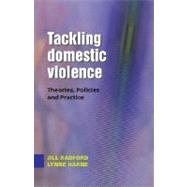
Tackling Domestic Violence Theories, Policies and Practice
by Harne, Lynne; Radford, JillRent Book
New Book
We're Sorry
Sold Out
Used Book
We're Sorry
Sold Out
eBook
We're Sorry
Not Available
Summary
Author Biography
..Jill Radford is Professor of Criminology and Womenn++s Studies at the University of Teesside, UK. She has been working around the issues of sexual and domestic violence for 30 years and is a founding member and Chair of the Tees Valley Sexual Violence Forum and a member of the Middlesbrough Domestic Violence Forum..
Table of Contents
| Preface | p. vii |
| Acknowledgements | p. viii |
| Introduction | p. ix |
| The nature and extent of domestic violence | p. 1 |
| The nature of domestic violence | p. 1 |
| The power and control wheel | p. 7 |
| Diversity in women's experiences of domestic violence | p. 9 |
| Domestic violence as gender violence | p. 17 |
| Domestic violence as crime | p. 20 |
| Prevalence of domestic violence | p. 23 |
| Conclusion | p. 31 |
| Impacts, coping and surviving domestic violence | p. 37 |
| The impacts on women | p. 37 |
| Injuries and ill-health | p. 38 |
| Recovering from the health impacts of domestic violence | p. 44 |
| Why don't women just leave? | p. 46 |
| Implications for practice | p. 54 |
| The impacts on children | p. 56 |
| Children living with domestic violence | p. 64 |
| Post-separation violence | p. 66 |
| The direct abuse of children during contact visits | p. 69 |
| Understanding children's perspectives-implications for practice | p. 73 |
| Legal responses to domestic violence | p. 85 |
| The nature of law in liberal democratic theory | p. 85 |
| Feminist perspectives | p. 87 |
| Legal change in the 20th Century | p. 92 |
| Feminist jurisprudence | p. 93 |
| The advantages and disadvantages of civil legislation | p. 98 |
| The criminal law | p. 99 |
| Domestic homicide | p. 101 |
| Family law | p. 104 |
| The Children Act (1989) | p. 105 |
| The law & child contact in cases of domestic violence | p. 107 |
| Child protection (Public law) | p. 110 |
| Conclusions | p. 111 |
| Policing, prosecution and the courts | p. 117 |
| Policing domestic violence | p. 117 |
| Innovate policing practice | p. 122 |
| Policing and attrition | p. 130 |
| Further policing initiatives | p. 133 |
| Prosecution and the courts | p. 135 |
| Specialist domestic violence courts | p. 137 |
| New sentencing guidence | p. 140 |
| Conclusions | p. 141 |
| Preventing domestic violence | p. 147 |
| The need for primary prevention | p. 147 |
| Perpetrator programmes - tertiary prevention | p. 152 |
| Do perpetrator programmes work? | p. 159 |
| Perpetrator programmes, violent fathers and children's safety | p. 162 |
| Conclusions | p. 164 |
| Community responses to domestic violence | p. 169 |
| Customary community responses | p. 169 |
| Women's Aid | p. 170 |
| Multi-agency responses | p. 177 |
| Multi-agency practices today | p. 182 |
| Multi-agency risk assessment conferences | p. 183 |
| Conclusion | p. 187 |
| Table of Contents provided by Ingram. All Rights Reserved. |
An electronic version of this book is available through VitalSource.
This book is viewable on PC, Mac, iPhone, iPad, iPod Touch, and most smartphones.
By purchasing, you will be able to view this book online, as well as download it, for the chosen number of days.
Digital License
You are licensing a digital product for a set duration. Durations are set forth in the product description, with "Lifetime" typically meaning five (5) years of online access and permanent download to a supported device. All licenses are non-transferable.
More details can be found here.
A downloadable version of this book is available through the eCampus Reader or compatible Adobe readers.
Applications are available on iOS, Android, PC, Mac, and Windows Mobile platforms.
Please view the compatibility matrix prior to purchase.
